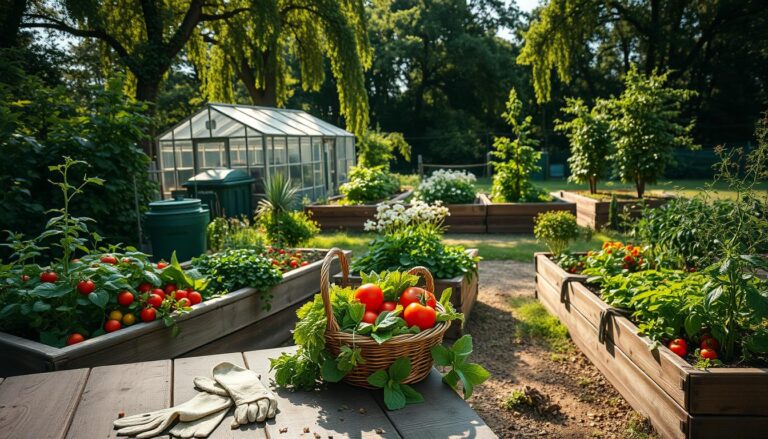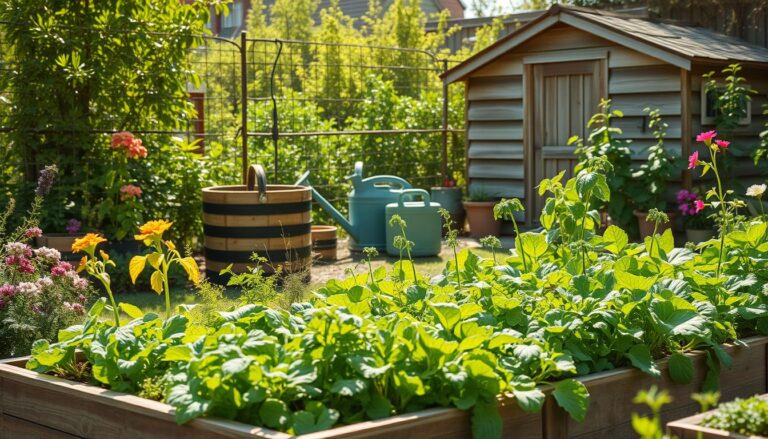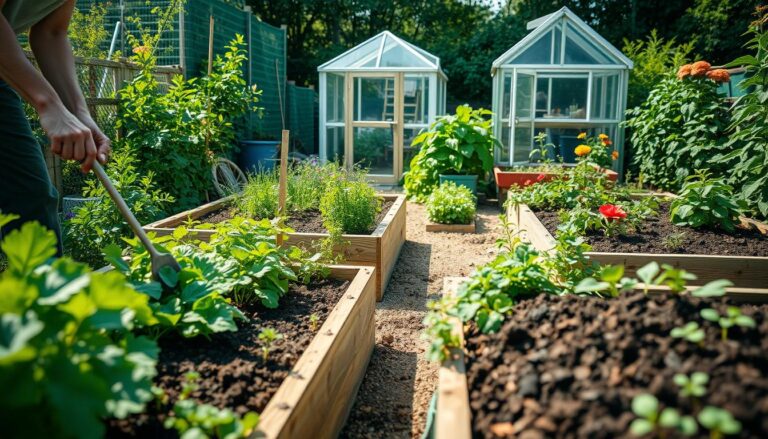Gardeners know how key it is to have healthy, nutrient-rich soil for plants to grow well. Using sustainable practices is vital to boost soil fertility and structure. This helps gardeners create a great place for their plants to thrive.
Organic soil management uses methods that work with nature. It improves soil health and supports a balanced ecosystem. This makes gardens more productive and strong.
Using these sustainable methods, gardeners get many benefits. They see better crop yields and less harm to the environment.
Understanding Organic Soil Management
Organic soil management is a way to make soil better naturally. It’s great for gardeners who want healthy plants without synthetic stuff. This method helps plants grow well without harmful chemicals.
What is Organic Soil Management?
It’s about making soil better with natural ways. This includes composting, mulching, and changing what you grow. These steps help create a good environment for plants and other living things.
The main idea is to work with nature, not against it. This means not messing with the soil too much and using natural helpers to make it better.
Benefits of Organic Soil Management
There are many good things about organic soil management. It makes soil better, which means plants grow more and soil is healthier. It also helps the planet and saves water, making it a smart choice.
- Increased crop yields due to improved soil fertility
- Enhanced soil biodiversity, supporting a healthy ecosystem
- Reduced environmental impact through the use of natural amendments
- Improved water conservation through better soil structure
Learning and using organic soil management helps gardens grow strong and healthy. It’s good for the planet and makes gardening better for everyone.
The Importance of Soil Health
Soil health is key to a thriving garden. It affects plant growth and keeps the ecosystem balanced. For gardeners, it’s essential to understand and keep the soil healthy for eco-friendly soil management.
A healthy soil ecosystem is full of life. It has microorganisms that break down organic matter, fix nitrogen, and fight diseases.
Key Indicators of Healthy Soil
There are several signs to check if your soil is healthy. These include:
- Soil structure and aggregation
- Soil pH and its impact on nutrient availability
- Microbial activity and diversity
- Presence of organic matter
- Soil biodiversity
| Indicator | Description | Importance |
|---|---|---|
| Soil Structure | The arrangement of soil particles and pores | Affects water infiltration, aeration, and root growth |
| Soil pH | A measure of soil acidity or alkalinity | Influences nutrient availability and microbial activity |
| Microbial Activity | The activity level of microorganisms in the soil | Critical for decomposition, nitrogen fixation, and disease suppression |
Role of Soil Microorganisms
Soil microorganisms are crucial for soil health. They help plants grow and support the ecosystem. By using organic gardening techniques, gardeners can help these microbes thrive.
These microorganisms break down organic matter, make minerals available, and help plants grow. They also fight off plant diseases, reducing the need for pesticides.
Principles of Organic Soil Management
The heart of regenerative soil care is knowing and using the main rules of organic soil management. This method aims to make the soil a balanced and lively ecosystem.
Two key principles are essential for this balance: less soil disturbance and keeping the soil covered. By following these steps, gardeners can greatly boost soil health and fertility.
Minimizing Soil Disturbance
Less soil disturbance is a key rule that means doing less tillage and other actions that mess with the soil’s structure. This keeps the soil’s organic matter, helps the soil life, and makes the soil better. Reduced tillage also stops soil erosion and lets water soak in better.
Maintaining Soil Cover
Keeping the soil covered is another key rule that uses cover crops, mulching, and other methods to keep the soil covered all year. This helps stop soil erosion, keeps the soil healthy, and supports different life forms. Cover crops, for example, add organic stuff, make the soil richer, and help beneficial bugs.
By following these rules, gardeners can make a soil ecosystem that’s strong and productive. This matches the aims of holistic soil improvement.
Techniques for Managing Organic Soil
To make soil sustainable, several key techniques are helpful. These methods not only make soil healthier but also help the environment. They are great for gardening and farming.
Composting for Nutrient-Rich Soil
Composting is a great way to make soil rich in nutrients. It turns organic materials into something plants can easily use. You need to mix “green” materials (like kitchen scraps) with “brown” materials (like dried leaves).
Good composting reduces waste and makes soil better for plants.
- Include a mix of green and brown materials.
- Maintain adequate moisture and aeration.
- Monitor temperature to ensure optimal decomposition.
Crop Rotation and Diversity
Crop rotation and diversity are key for healthy soil. Rotating crops helps avoid pests and diseases. It also makes soil richer and boosts crop yields. Growing different crops increases soil life.
- Rotate crops to avoid depleting soil nutrients.
- Include legumes to fix nitrogen.
- Use cover crops to protect and enrich the soil.
Mulching: Benefits and Best Practices
Mulching is great for organic soil. It keeps moisture in, stops weeds, and controls soil temperature. Organic mulches like wood chips or straw are best because they add to the soil over time.
For good mulching, use enough, avoid too dense or fine mulch, and replace it when needed.
Using these methods can greatly improve soil health. This leads to more sustainable gardening and farming.
Choosing Organic Amendments
Organic amendments are key to keeping soil healthy and making nutrients available for plants. By picking the right ones, gardeners can boost soil fertility and help plants grow well.
Types of Organic Fertilizers
There are many organic fertilizers to choose from. Compost is full of nutrients and good microbes. Manure slowly releases nutrients, and green sand is a natural source of iron and other micronutrients.
Each fertilizer has its own benefits. Compost can make soil better for plants to grow in. Manure gives plants a nutrient boost.
How to Apply Organic Amendments
Using organic amendments right is important. You need to think about soil type, crop requirements, and application rates. First, test your soil to know its nutrient and pH levels.
After picking the right amendment, apply it as suggested. Compost can be spread on top or mixed into the soil. Manure should be aged or composted first to prevent harming plant roots.
- Test your soil to determine its nutrient content and pH level.
- Choose the right organic amendment based on your soil test results and crop requirements.
- Follow the recommended application rates for the chosen amendment.
Water Management in Organic Soil
Organic soil management thrives on water conservation and smart irrigation. Organic gardening focuses on soil health, and water management is key. It’s all about keeping the soil in top shape.
Importance of Water Conservation
Water conservation is vital for organic gardening. Efficient water use cuts down environmental harm and boosts soil health. It’s all about reducing evaporation and runoff.
Mulching is a top water-saving method. Organic materials like straw or wood chips cover the soil. This keeps the soil cool and moist, cutting down on watering needs.
Techniques for Efficient Irrigation
Good irrigation is crucial for organic soil care. Drip irrigation sends water straight to plant roots. This method cuts down waste and evaporation, giving plants just the right amount of water.
| Irrigation Technique | Description | Benefits |
|---|---|---|
| Drip Irrigation | Delivers water directly to plant roots | Reduces water waste, minimizes evaporation |
| Sprinkler Irrigation | Distributes water over a wide area | Effective for larger areas, can be automated |
| Soaker Hoses | Releases water along the length of the hose | Efficient for watering rows of plants, reduces runoff |
As
“The way we manage water in our gardens directly impacts the health of our soil and the productivity of our plants.”
Good water management is more than saving water. It’s about building a strong, thriving garden ecosystem.
By using these eco-friendly methods, gardeners can keep their soil healthy and productive. This supports a wide variety of plants.
Managing Soil pH
Soil pH is key for plant nutrition, making it crucial for regenerative soil care. It’s important to manage soil pH well for a healthy soil environment.
Soil pH affects how plants get nutrients. Most plants do best in slightly acidic to neutral soil, with a pH of 6.0 to 7.0. Knowing your soil’s pH is the first step to a good growing environment.
Testing Soil pH Levels
Testing your soil’s pH is easy with DIY kits or lab analysis. Accurate pH testing is vital to see if your soil is too acidic or alkaline.
When testing, take samples from different garden spots. This gives a true pH reading. It helps spot pH differences for better adjustments.
Adjusting pH Naturally
To change soil pH naturally, use organic materials. To lower soil pH, add elemental sulfur or peat moss. To raise soil pH, lime is the go-to.
Adding organic matter like compost helps stabilize pH. As compost breaks down, it adds nutrients and improves soil structure. This helps plants grow better.
- Add elemental sulfur or peat moss to lower soil pH.
- Use lime to raise soil pH.
- Incorporate organic matter like compost to stabilize soil pH.
Understanding and managing soil pH well helps gardeners improve soil health. This not only boosts plant growth but also supports a healthy soil ecosystem.
Common Challenges in Organic Soil Management
Organic soil management has many benefits but also faces challenges. Gardeners and farmers often deal with issues that affect soil health and productivity. It’s important to understand these challenges and find effective solutions to keep the soil healthy and rich in nutrients.
Dealing with Soil Erosion
Soil erosion is a big problem in organic soil management. It happens when wind or water wears away the soil, losing valuable nutrients. To fight soil erosion, gardeners can use terracing and cover cropping.
Terracing creates flat plots on slopes to stop erosion. Cover cropping plants hold the soil in place. These methods help keep the soil healthy and prevent erosion.
Mulching is another great way to stop erosion. It involves adding organic material to the soil surface. Mulching protects the soil, keeps moisture in, and stops weeds. By using these methods, gardeners can keep their soil safe from erosion.
Pest Management Strategies
Pest management is a big challenge in organic soil management. Gardeners often face pests that harm crops and lower yields. To manage pests, gardeners can use crop rotation and biological control.
Crop rotation breaks the pest life cycle. Biological control uses natural predators or parasites to control pests. These strategies help gardeners keep pests away and maintain healthy soil.
Other good ways to manage pests include using physical barriers and practicing good sanitation. Physical barriers stop pests from reaching crops. Good sanitation reduces pest risks. By using these methods, gardeners can effectively manage pests and keep their soil healthy.
Resources for Learning More
To learn more about organic soil management, it’s key to check out more resources. They offer insights into natural fertilization and improving soil health.
Recommended Reading and Guides
There are many books and guides that dive deep into organic soil management. For example, “Organic Gardening: The Definitive Guide” is a great resource. It covers how to keep your soil healthy.
These guides keep gardeners up-to-date with the latest in soil care. They teach the best ways to improve soil health.
Online Communities and Forums
Joining online communities and forums is a great way to meet other gardeners. You can share your experiences and learn from experts. Sites like Reddit’s Organic Gardening community are perfect for this.
They let you talk about natural fertilizers and other gardening topics. It’s a place where gardeners can help each other grow and learn.
FAQ
What is the importance of minimizing soil disturbance in organic soil management?
How can I improve soil fertility using natural fertilization methods?
What are the benefits of using cover crops in organic soil management?
How can I manage soil pH naturally?
What are some effective techniques for efficient irrigation in organic soil management?
How can I deal with soil erosion in my garden?
What are some regenerative soil care practices I can implement in my garden?
How can I optimize soil health using holistic soil improvement methods?

Sortemdia nasceu com o propósito de trazer alegria e oportunidades para todos por meio de sorteios gratuitos de prêmios incríveis. O site tem como missão oferecer experiências acessíveis, divertidas e justas para quem deseja concorrer a produtos, serviços e brindes sem pagar nada por isso. Acreditamos que a sorte pode bater à porta de qualquer pessoa — e no Sortemdia, ela pode chegar com apenas um clique.



